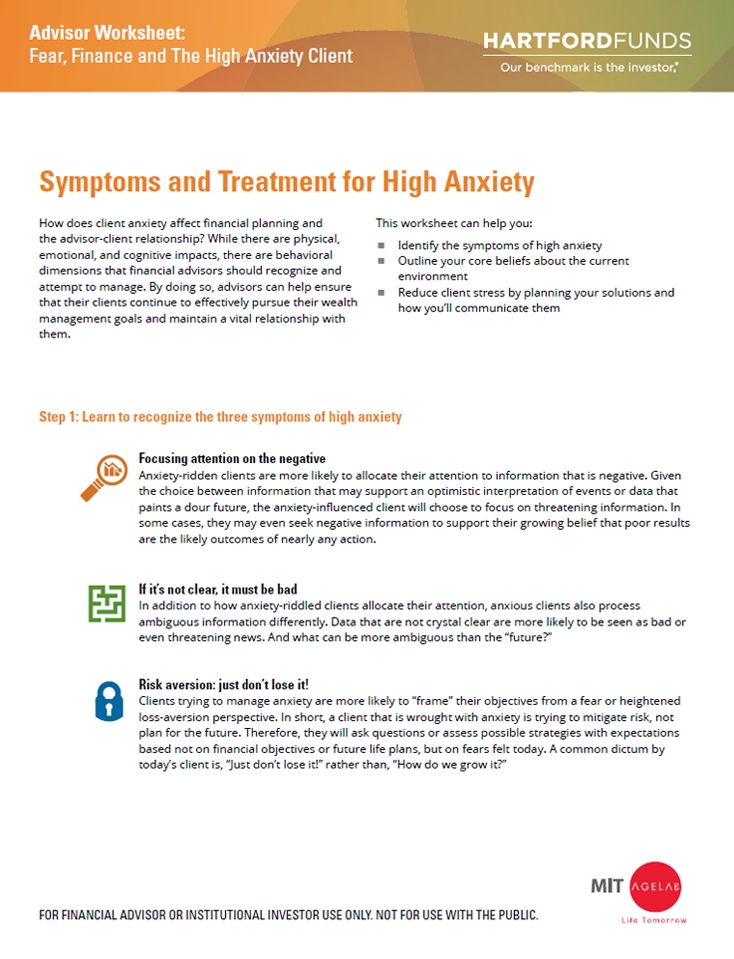How does client anxiety affect financial planning and the financial professional-client relationship? While there are physical, emotional, and cognitive impacts, there are also behavioral dimensions that financial professionals should recognize and attempt to manage. Helping clients address their anxiety results in a deeper client-financial professional relationship and helps clients more effectively pursue their wealth management goals.
Three Behavioral Patterns to Watch for:
A step-by-step approach to communication will produce both an effective plan for the client and a means to mitigate high anxiety.
Focusing Attention on the Negative
Anxiety-ridden clients are more likely to allocate their attention to negative information. Given the choice between information that may support an optimistic interpretation of events or data that paints a dour future, the anxiety-influenced client will choose to focus on threatening information. In some cases, they may even seek negative information to support their growing belief that poor results are the likely outcomes of nearly any action. For example, rather than seeking to learn more about a firm or a fund that has growth potential, consumers feeling anxiety will want more information about a recent jobs report showing a downward trend or to discuss the impact of uncertain foreign markets on the performance of the U.S. economy.
If It’s Not Clear, It Must Be Bad
In addition to how anxiety-ridden clients allocate their attention, anxious clients also process alternative viewpoints or complex issues differently. Data that are not crystal clear are more likely to be seen as bad or even threatening news. And what can be more ambiguous than the “future?”
Even when the economy is thriving, the media seem to delight in finding a reason why the good times won’t continue. Positive economic reports are often downplayed in favor of the not-so-bright side. Is it any wonder why investors are left feeling uneasy?
Financial planning is inherently ambiguous. Despite their inherent complexity, models of “future” performance are… well, models of what might be with varying degrees of confidence. A nervous client’s initial “gut check” will interpret that inherent ambiguity and margin of error, even with the best expert’s guidance, as a greater probability of a negative outcome.
Risk Aversion: Just Don’t Lose It!
Social and behavioral scientists refer to how alternatives or issues are presented as “framing.” For example, consider these two questions you could ask a client: “Would you consider moving to a different state in retirement?” vs. “Which state are you considering for retirement?” Both questions address the same issue, but the first is more passive and leaves open a range of possibilities for retirement living, while the second implies that the client is moving—only the destination is uncertain.
Clients trying to manage anxiety are more likely to “frame” their objectives from a fear or heightened loss-aversion perspective. In short, a client that is wrought with anxiety is trying to mitigate risk, not plan for the future.
Therefore, they will ask questions or assess possible strategies with expectations based not on financial objectives or future life plans, but on fears felt today. A common dictum by today’s client is “Just don’t lose it!” rather than “How do we grow it?”
Expect Anxiety to Remain High
Just as a good doctor knows how to treat the whole patient, rather than just a condition, financial professionals must be prepared to actively address how their clients feel as well as how they invest. Client anxiety has remained high because of things such as political dysfunction, climate change, and a pandemic.
This pattern of events suggests that investor anxiety may remain elevated or even increase.1 Clients who no longer open statement envelopes, ignore phone calls, or choose cash investments are perhaps the most anxiety-ridden, while those who still engage with their professionals or at least open the mail are still in a state of high anxiety.
Financial professionals must acknowledge this continuing fear in the marketplace and seek opportunities to check in with clients to show they care. They can help clients and their families cope by developing new narratives and tools to explain market realities to counter negative bias, and by offering products that respond to their clients’ needs to balance risk with growth.
How to Help Clients Manage Their Anxiety
- Discuss current events and family dynamics: Engaging the client in ‘small talk’ about current events and family news does more than maintaining a relationship; it provides insight into how well your client is coping with market anxiety, and how they might be behaving in other aspects of their lives (e.g., career, family, purchasing behaviors, etc.). These behaviors may indicate how much anxiety they’re feeling and how active you need to be in helping them cope. Moreover, it’s an opportunity to show that you care.
- Point to the positive: Help clients see positive indicators without ignoring their discomfort, or providing an excessively optimistic response that may be perceived as condescending or unrealistic. For example, describe how one data point doesn’t make a trend or how one industry doesn’t shape an entire economy.
- Become an engaging educator: Financial professionals must take more time to educate clients on more than products, such as the changing economic environment and its possible impact on current investments and plans. Rather than simply providing “more information,” it’s imperative to provide clarity—information in small, easy-to-digest elements. For example, leading hospitals and physicians now direct patients to interactive websites, videos, short documents, and creative multimedia sources to educate patients and families about a given chronic condition rather than a single letter, report, or discussion.
- Provide informed insights about past and future patterns: Financial professionals should provide information that tempers negative stories or data and helps clients see trends or think long term. Show how past cycles or events eventually came to a positive conclusion. Make the case for a diversified portfolio consisting of stocks combined with asset classes (e.g., fixed income) that may be seen as less volatile and less subject to global mood swings (e.g., commodities).
- Encourage clients to limit their news consumption: Repetitive crisis reporting can make it easy for clients to become discouraged and lose sight of their long-term financial goals. Recommend that clients keep their internet use to a minimum and rely on trusted sources of information. Both of these can lessen the risk of triggering anxiety.
- Facilitate action: Anxiety biases clients toward negative perceptions and inaction. However, taking action, even if it’s just a first conversation toward a comprehensive plan, often improves the client’s confidence and helps manage fear.








